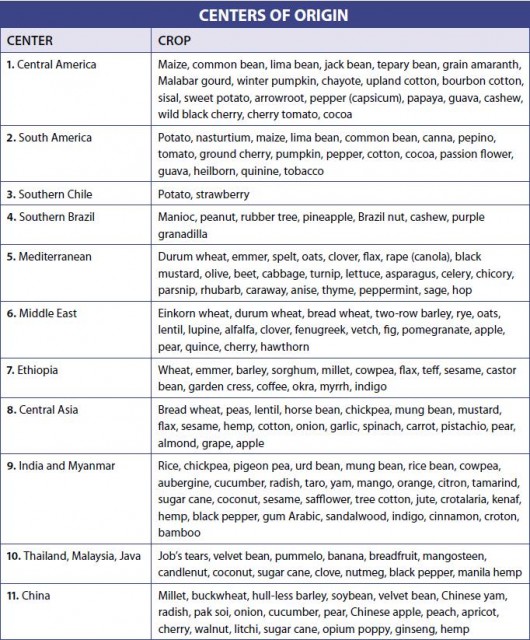Nikolai Vavilov and the Origin of Cultivated Plants
When early farmers first began to select the plants that they wished to grow, they chose individuals with certain characteristics. In the case of cereals, for example, they selected plants with a tough rachis and a large store of endosperm. In selecting for certain traits, farmers gradually altered the genetic constitution of their crop plants, and later plant breeders carried the process much further, so today most domesticated plants belong to different species from their wild ancestors. This was the process Darwin used as a metaphor for natural selection.
In the early 20th century a Russian botanical geneticist realized that artificial selection and the geographic spread of agriculture using a limited number of crop species had an interesting implication. Farmers and then plant breeders selected the traits that they considered useful from the variety of traits present in the wild plants. Each time they did so, however, they also rejected all those plants that lacked the desired trait, and they repeated this for trait after trait and generation after generation. Consequently, the amount of natural variation in the crop species slowly diminished. This might pass unnoticed, but agriculture also spread geographically, which suggested that the amount of natural variation in a cultivated species diminished with increasing distance from the region where it was first domesticated. Nikolai I. Vavilov (1887–1943) believed he could measure natural variation and use it to identify the regions where particular crops had first been cultivated. He called those regions centers of origin. They were also centers of diversity, because within them there is the greatest genetic variation in the species in question.

Between 1916 and 1935 Vavilov conducted more than 100 missions to collect plant specimens that he studied in his laboratory at the University of Saratov. He visited Iran, the United States, Central and South America, Afghanistan, the Mediterranean, Ethiopia, China, and South Asia. In 1926 he published The Centers of Origin of Cultivated Plants. The following illustration shows that he identified 11 of these. The table that follows lists the crops that originated in each center; some crops were domesticated more than once.
Nikolai Ivanovich Vavilov was born in Moscow on November 25, 1887, into a prosperous merchant family. He studied at the Moscow Agricultural Institute, graduating in 1910, and spent 1911 and 1912 working at the Bureau for Applied Botany and the Bureau of Mycology and Phytopathology. (Mycology is the scientific study of fungi; phytopathology is the study of plant diseases.) In 1913 and 1914 he continued his studies in England, first at the School of Agriculture at Cambridge University and later at the John Innes Horticultural Institution. After returning to Russia he began to investigate the origin of cultivated plants.
In 1917 Vavilov was made a professor at the University of Saratov. He stayed there until 1921, when he was assigned to the Bureau of Applied Botany in Petrograd (now St. Petersburg). He was director of the Institute of Applied Botany from 1924 to 1929, a full member of the USSR Academy of Sciences, director of the All-Union Institute of Plant Breeding from 1930 to 1940 and of the Institute of Genetics from 1933 to 1940, president in 1929 and vice president from 1935 to 1937 of the Lenin All-Union Academy of Agricultural Sciences, and from 1931 to 1940 he was president of the All-Union Geographical Society. He was invited to be president of the International Congress of Genetics held in 1939, and in 1940 he was elected a foreign member of the Royal Society.

In the 1920s, Vavilov befriended Trofim Denisovich Lysenko (1898–1976), a talented young agronomist, and began taking him to scientific meetings. Lysenko was very popular with farmers, and when he declared that he had discovered techniques for hybridizing plants to produce permanent physiological improvements and for fertilizing the fields without using mineral fertilizers, his popularity grew. The USSR was desperately short of food, and the idea that improving the environment could result in heritable improvements in plants fitted the official ideology—that people are the product of their environment—and captured the attention of senior politicians, eventually including Stalin.
Lysenkoism also rejected the entire concept of genetics. Lysenko was never able to produce any evidence that his theories worked, but nevertheless he became increasingly powerful and his supporters began to attack the geneticists for generating scientific papers but doing nothing to feed the people. A Congress on Genetics and Agriculture was held in 1936 with the purpose of discrediting the geneticists, and in 1939 a Congress on Genetics and Selection openly attacked Vavilov, who had grown increasingly outspoken in his condemnation of Lysenko's perversion of science. In 1940 Vavilov was arrested and subsequently tried, essentially for opposing the official doctrine. He was sentenced to death, but in 1942 the sentence was commuted to a 20-year prison term. Vavilov's closest colleagues were dismissed from their positions, and many were imprisoned. Vavilov was imprisoned at Saratov, where he died from malnutrition on January 26, 1943.
During the 1950s, following Stalin's death, mainstream scientists began to be more outspoken in their criticisms of Lysenko. This culminated in 1964 with Lysenko's dismissal from his position as director of the Institute of Genetics at the USSR Academy of Sciences. He continued to work at an experimental farm outside Moscow, and the institute was later dissolved. An expert commission was appointed to investigate the records Lysenko kept at the experimental farm. Its report was strongly critical of Lysenko, and it was made public. Lysenko was disgraced, and in the years that followed Vavilov was officially rehabilitated.
- Gote Turesson and Plant Ecotypes
- Asa Gray and the Discontinuous Distribution of Plants
- Charles Darwin and Evolution by Means of Natural Selection
- Adolphe-Theodore Brongniart, Father of Paleobotany
- How Rubber Moved to Asia
- Sir Hans Sloane, Milk Chocolate, and the British Museum
- How Brazil Acquired Its Name
- Coffee, and Kaldi’s Goats
- Tea, and How Bodhidharma Stayed Awake